Best 3L Snowboard Shell
TREW Cosmic Jacket Primo
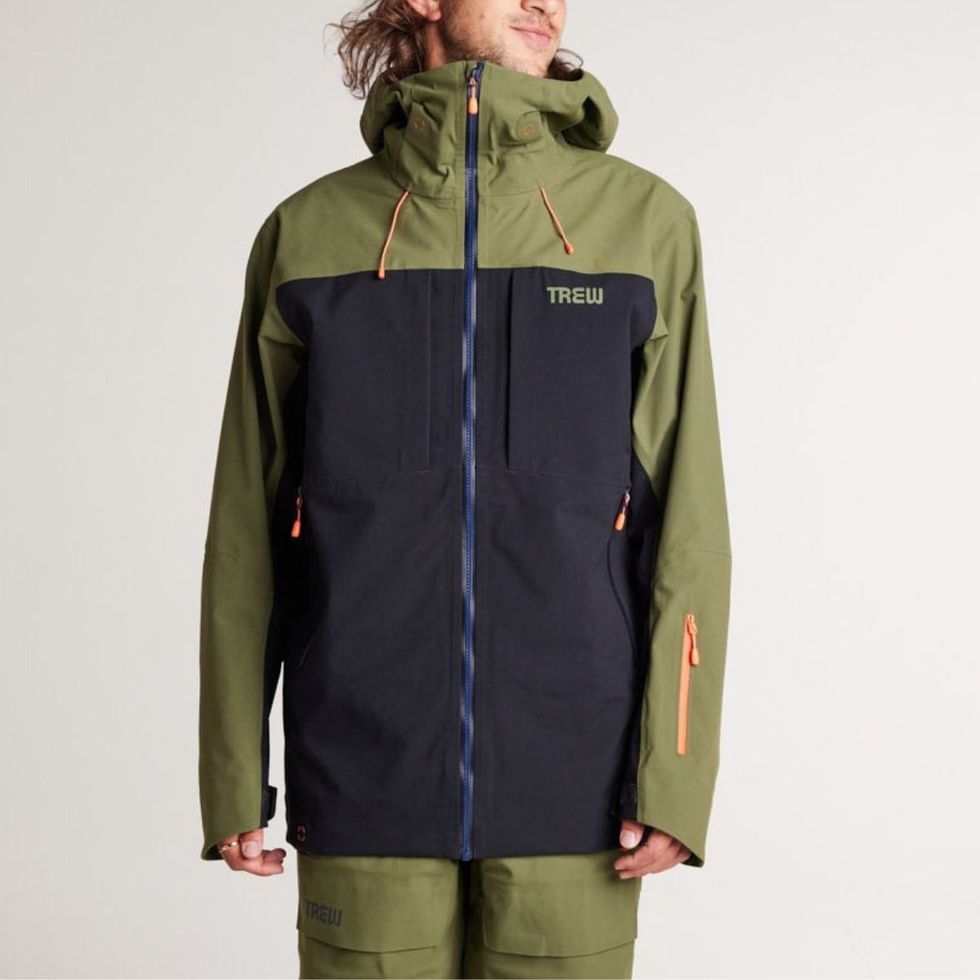
Best 3L Snowboard Shell
TREW Cosmic Jacket Primo
Pros
- Heavy-duty fabric is warm and durable
- Extremely breathable and waterproof
- Oversized hood with three-point adjustment
- Sustainable, Bluesign-certified 100% recycled Primo fabric
- Plenty of storage
Cons
- Pricey for beginner snowboarders
The Cosmic 3L Primo Jacket from Trew Gear is not only one of the brand’s originals but also its best-selling snowboard jacket. With bombproof durability, fantastic breathability and waterproofing, and bold good looks, we’re not surprised.
This is a high-performance, non-insulated shell jacket designed for serious backcountry skiers and snowboarders. It’s made with a 3L Primo fabric that’s fully seam-taped with 3L tape for maximum breathability and waterproofing. With a 20,000mm waterproof rating and a 20,000g/m2 breathability rating, it’s the highest-rated snowboard jacket Trew Gear offers. Our team found the fabric to be denser than most other jackets we tested, which really gives it an edge in keeping wind and snow out. The solid list of features includes a relaxed fit, articulated sleeves, 16-inch pit zips, and a helmet-compatible hood, making it ideal for long days in the mountains. Bonus: Four oversized external zippered pockets and a pass pocket, plus two large mesh dump pockets on the inside, all add up to plenty of storage.
The Cosmic 3L pulls no punches. This is a no-compromises design that’s built for all but the most technical mountain assaults. At just under $500, it’s pricier than most we tested. But given its incredibly durable design with breathable, comfortable, and (most importantly) waterproof fabric, plus a long list of built-in features, we think it’s a steal.
Read more: Best Base Layers
| Category | Non-insulated shell |
|---|---|
| Insulation Type | None |
| Waterproofing | 20,000mm-rated membrane |
Best 2L Snowboard Shell
686 GT Gore-Tex Jacket

Best 2L Snowboard Shell
686 GT Gore-Tex Jacket
Pros
- Versatile shell design
- Genuine Gore-Tex is breathable and waterproof
- Roomy fit with a soft, Merino-lined collar
- Compact roll-up design
- Plenty of storage
Cons
- Arms run a little long
We’ve long been fans of 686, and the brand’s GT Gore-Tex Jacket stands out as a compelling snowboard jacket, promising both performance and comfort on the slopes. The relaxed-fit, medium-weight design balances warmth, mobility, and comfort for a wide range of winter sports.
The standout feature of this snowboarding shell is its genuine two-layer Gore-Tex membrane. It’s a best-in-class design and, coupled with fully-taped seams and water-resistant zippers, boasts a 20,000mm waterproof rating and a 20,000g/m2 breathability rating. Translation: It’s great at keeping the wet stuff off you and extremely effective at releasing excess moisture from snow, freezing rain, slush, and sweat. The generous fit and articulated sleeves also make for easy layering and a better range of motion.
Other features we like include pit zips and mesh-lined underarm vents to increase airflow, adjustable cuffs and a cinchable hem, and a Merino-lined collar that’s way softer and more comfortable than most snowboard jackets we tested. It all rolls up into the built-in hood for easy packing.
We especially love the price. With all of the above features and a rock-solid overall design, this is a great buy at less than $400. all of which is why it’s our pick as this year’s best two-layer snowboard jacket.
Read more: Best Fleece Jackets
| Category | Non-insulated shell |
|---|---|
| Insulation Type | None |
| Waterproofing | 2L Gore-Tex |
Best Mid-Tier Priced Snowboard Jacket
Burton AK Gore-Tex Cyclic Jacket
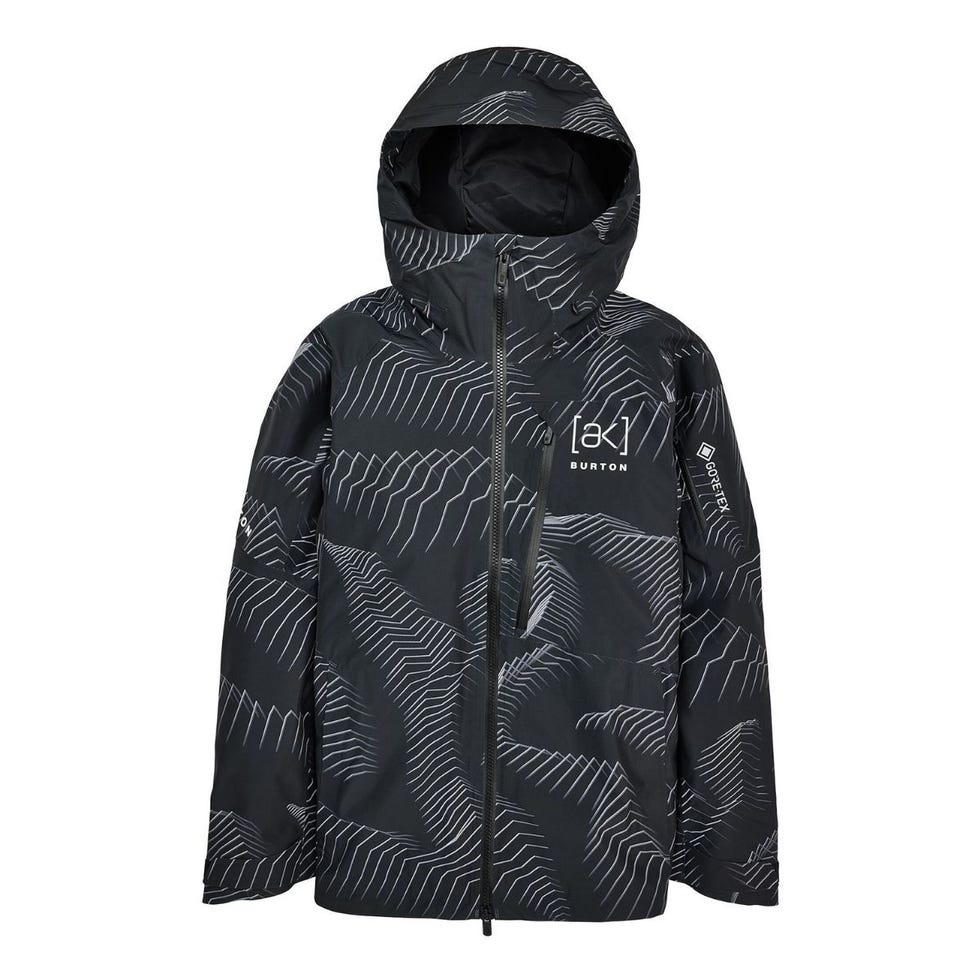
Best Mid-Tier Priced Snowboard Jacket
Burton AK Gore-Tex Cyclic Jacket
Pros
- Premium design and quality
- Protects well against the elements
- Soft, comfortable inner liner
- Insulated phone pocket, pit zips, and glove-friendly zippers
Cons
- Popular colors sell out fast in major sizes
- Pricey
You just can’t go wrong with Burton. Like everything in the company’s deep catalog of ski and snowboard gear, the AK 2L Gore-Tex Cyclic snowboard jacket features a premium, spare-no-expense construction that holds up well on the trail, protects well against the elements, and features a plush inner liner that’s surprisingly comfortable too.
As part of Burton’s fan-favorite AK line-up, the Swash is one of the brand’s more premium snowboard jackets. There’s no insulation, as it’s only a shell jacket. The lack of insulation though allows for much better breathability on the slope, and allows for less chance of overheating.
“I like that this jacket is thin and breathable, yet built well enough to still keep me warm before activity,” said tester Mike Richard. “It hits that sweet spot for me, as I’d rather side towards less insulation than more since I know I’ll be sweating on the mountain.”
Our testers also like the addition of nice-to-have features like an insulated phone pocket (great for keeping your battery happy in cold weather), pit zips, and oversized zippers that play nice with winter gloves and mittens.
Overall, this jacket has a great mix of build quality and features, albeit at a slightly higher price than some of our more affordable options. Still, this is a solid option if you’re looking to graduate from a budget jacket, but not quite ready to splash out on a premium model in the $700-plus range.
Read more: Burton [AK] Hover Stretch Review
| Category | Shell |
|---|---|
| Insulation Type | None |
| Waterproofing | 2L Gore-Tex |
Advertisement – Continue Reading Below
Best Snowboard Jacket for Beginners
Quiksilver Mission Solid Jacket
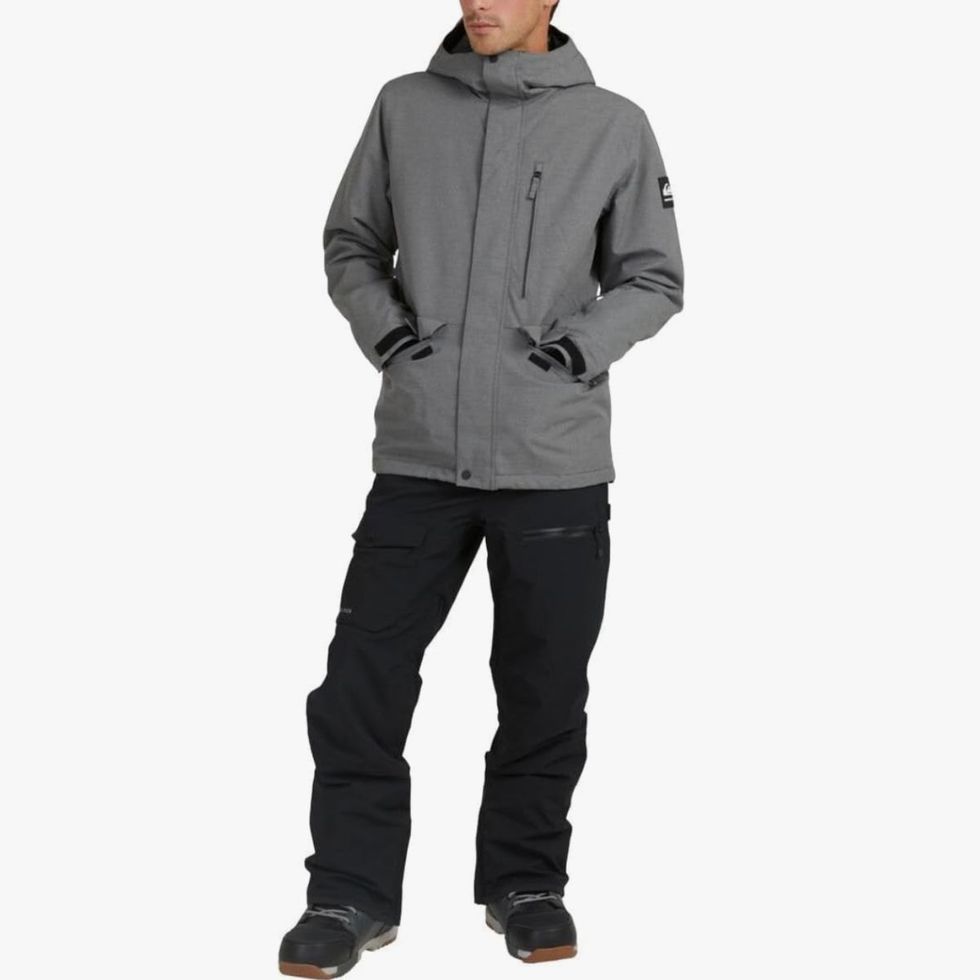
Best Snowboard Jacket for Beginners
Quiksilver Mission Solid Jacket
Now 10% Off
Pros
- Great value with a good balance of features and price
- Plenty of insulation to keep you warm
- Built-in powder skirt and five pockets
Cons
- Not great in very wet conditions
You can easily drop $700 or more on a super-premium, highly technical snowboard jacket. But not everyone needs to go all-in on a jacket, especially if you’re a beginner or tend to stick to groomed resort trails. That’s where Quiksilver’s Mission Solid Jacket comes in.
This snowboard jacket ticks all the must-have boxes. The 2L DryFlight outer layer does a solid job of protecting against wind and snow. Plus, it features a powder skirt and five pockets (including a pass-specific pocket on the sleeve). As a true insulated jacket, it’s also surprisingly warm for a jacket in this price range, featuring 100g fill in the core and body and 80g fill in the sleeves.
To make this jacket affordable to a wider audience, Quiksilver made some compromises that we think are worth it. The most obvious is the lackluster waterproofedness. The shell fabric does a decent—though not great—job of keeping water and wet snow out in slushier weather conditions. Quiksilver also only opted to tape the seams in a few key areas. All of this is fine for casual resort riders, but more enthusiastic boarders may want to look elsewhere. Still, we think it’s the best snowboard jacket for the $200 price tag.
| Category | Insulated |
|---|---|
| Insulation Type | 100g (body); 80g (sleeves); 60g (hood) |
| Waterproofing | 2L DryFlight |
Best Premium All-Around Snowboard Jacket
Outdoor Research Hemispheres II Jacket

Best Premium All-Around Snowboard Jacket
Outdoor Research Hemispheres II Jacket
Pros
- Best-in-class three-layer Gore-Tex design
- Extreme breathability and waterproofing
- Provides an excellent range of motion
- Plenty of storage, including internal pockets for skins
Cons
- Expensive
- Probably overkill for casual boarders
Outdoor Research has been a go-to brand for our editors and writers for years. It may not be the first name snowboarders think of for apparel, but its premium, three-layer Hemispheres II Jacket is one of the best snowboard jackets we tested this year. With best-in-class durability, breathability, mobility, and perfect comfort and wearability, it’s purpose-built for serious backcountry touring.
This is OR’s flagship snowboard jacket, built with three-layer Gore-Tex with Gore-branded stretch panels. Coupled with thoughtful design features like TorsoFlo side vents (these run all the way from the pits to the hem), it’s nearly perfect at keeping you dry and snow-free while dumping heat and regulating your body temperature when the going gets tough. The upgraded second version of the Hemispheres jacket relies on bluesign-approved materials—a guarantee of maximum sustainability and eco-friendly design. Plus, the latest iteration adds internal mesh dump pockets for storing everything up to and including skins.
At $650, this is undoubtedly a premium snowboard jacket designed for hardcore boarders. But, if you’re willing to splurge on an option that’s equally at home on well-groomed resort trails as it is off-piste, this is your man.
| Category | Non-insulated shell |
|---|---|
| Insulation Type | None |
| Waterproofing | 3L Gore-Tex; 2L Gore-Tex with Stretch Technology |
Best Midrange Snowboard Jacket
Patagonia Men’s Insulated Powder Town Jacket
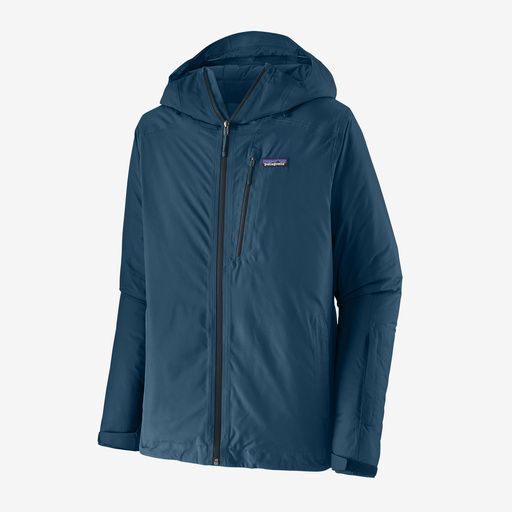
Best Midrange Snowboard Jacket
Patagonia Men’s Insulated Powder Town Jacket
Now 30% Off
Pros
- Solid midrange value jacket
- Proprietary H2No provides excellent waterproofing
- “Just right” insulation (not too warm)
- Soft polyester taffeta lining
- Eco-friendly design
Cons
- Not as breathable as a true 3L option
Patagonia’s Powder Town Jacket is a 2L snowboard shell that strikes a good balance between features, price, and comfort. It’s not the flashiest or the most technical, but it ticks all the must-have boxes for what we look for in a midrange powder coat.
This two-layer insulated jacket offers a good dose of insulation with 80g in the body and 40g at the sleeves—enough to keep you warm in most conditions without overheating. Just add an extra layer when the temperature drops. It’s lined with soft polyester taffeta that’s far more buttery and comfortable than most snowboard jackets at any price. It’s all wrapped in Patagonia’s own H2No waterproofing, which we’ve found to be almost as effective as Gore-Tex for handling the wet stuff. One thing that further sets this jacket apart is the company’s no-compromises approach to eco-friendly manufacturing. From the shell to the lining to the insulation, the Powder Town is made with 100% recycled polyester throughout. The jacket is Fair Trade Certified, so Patagonia gets a big fist-bump on that front too.
Resort riders who hit the slopes on more than just the weekends, but probably don’t have aspirations for tackling hardcore backcountry touring, will find the Powder Town most fitting. It’s available at a squarely midrange price point of just under $400 (retail).
Read more: Best Patagonia Jackets
| Category | Insulated |
|---|---|
| Insulation Type | 80g (body); 40g (sleeves) |
| Waterproofing | 2L H2No |
Advertisement – Continue Reading Below
Best Splurge Snowboarding Shell/Jacket
Arc’teryx Sabre Jacket
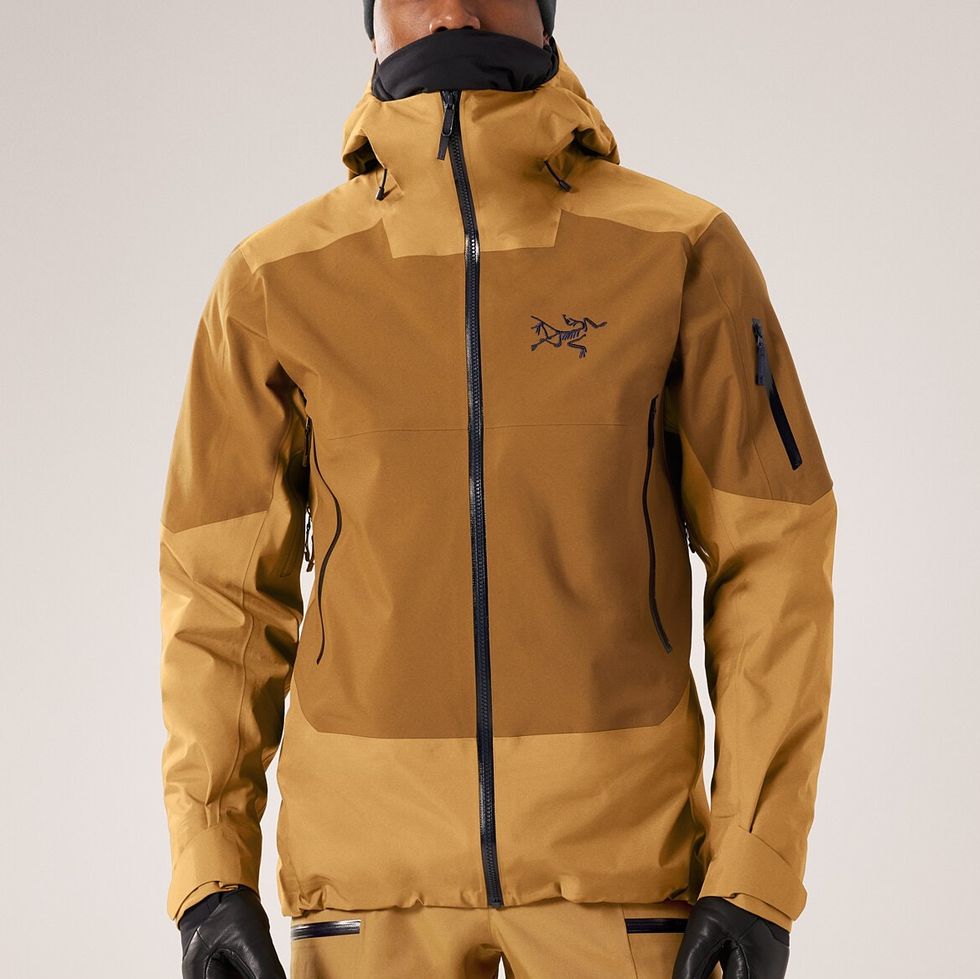
Best Splurge Snowboarding Shell/Jacket
Arc’teryx Sabre Jacket
Pros
- Ultra-premium look and feel
- Comfortable fit allows for maximum mobility
- Extremely durable face fabric
- Oversized, easy-to-adjust hood
- Lightweight, “barely there” feel
If “only the best will do,” you can always count on Arc’teryx. The Canadian brand makes some of the best technical gear in the world, and its Sabre Jacket is no exception for snowboarders looking for hardcore protection in the most challenging winter environments.
The Sabre is not just one of the best ski/snowboard shells, but one of the best all-around outdoor shells, period. It features an ultra-premium design that combines a featherweight construction with bulletproof durability and maximum mobility. The 3L Gore-Tex design is built for the worst and wettest conditions, so it’s ready for whatever nastiness the backcountry throws at you. We especially love the oversized hood that’s easy to cinch down or adjust on the fly.
Arc’teryx lightly updated this snowboard-worthy jacket for 2024 with a better fit and added an extra internal dump pocket in case you like to “go heavy” on the slopes.
We’re hard-pressed to find anything to complain about with this shell. It truly is a do-it-all, ready-for-anything jacket that’s tough enough to tackle all of your extreme outdoor adventures. Our only real gripe? The price. As with most Arc’teryx gear, you pay handsomely for the privilege of wearing it. In this case, that means a $200-plus premium over Burton’s very capable Cyclic jacket we recommended above.
| Category | Non-insulated shell |
|---|---|
| Insulation Type | None |
| Waterproofing | 3L Gore-Tex |
Best Value Gore-Tex Snowboard Jacket
Volcom L Insulated Gore-Tex Hooded Jacket

Best Value Gore-Tex Snowboard Jacket
Volcom L Insulated Gore-Tex Hooded Jacket
Pros
- Genuine two-layer Gore-Tex waterproofing
- “Just right” 80g/60g insulation
- Jacket-to-pant interface seals out snow
- Great storm hood
- Good price
Cons
- Plain looks
- Cheap mesh lining
Like Patagonia’s Powder Town above, Volcom strikes a good balance of features, price, and comfort in its L Insulated Gore-Tex Hooded Jacket. The genuine Gore-Tex waterproofing is an especially surprising and welcome addition at this price point.
It’s made with a two-layer Gore-Tex fabric that’s both waterproof and breathable. Insulation comes by way of 80/60g low-loft insulation to keep you warm while leaving plenty of room for layering without weighing you down. Like all of Volcom’s best hooded snowboard jackets, this model also features a great storm hood that’s easy to adjust and works exceptionally well, even on wet, nasty mountain days. Other nice-to-have features include goggle clips, a soft, super suede chin guard, mesh-lined pit vents, and a Zip Tech jacket-to-pant interface to keep snow out.
“Love, love, love the Zip Tech system on this one,” said John Thompson, our Senior Gear and Commerce Editor. “It seamlessly connects the jacket to my snowboarding pants for one-piece bib-like coverage.”
This is another great snowboard jacket that checks all the must-have boxes for us. Our only minor gripes are the cheap-o mesh lining and the boring aesthetic. It feels a bit dated and plain, and we wish Volcom offered more colorway and pattern options. Still, at around $350 (often significantly discounted on sale), we think this one is a bargain.
| Category | Insulated |
|---|---|
| Insulation Type | 80g (body); 60g (sleeves) |
| Waterproofing | 2L Gore-Tex |
Best 3-in-1 Snowboard Jacket
The North Face ThermoBall Eco Snow Triclimate 3-in-1 Jacket
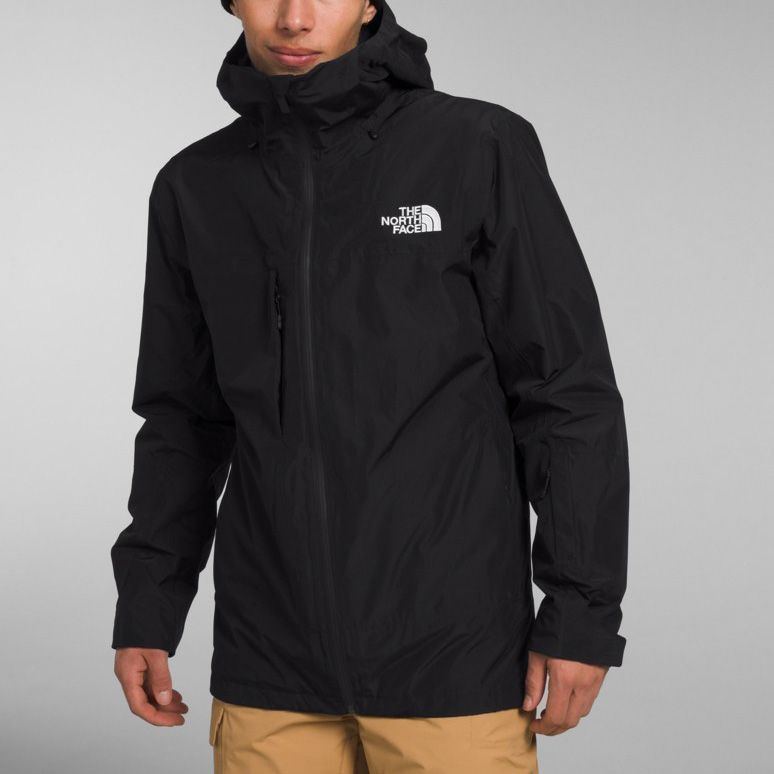
Best 3-in-1 Snowboard Jacket
The North Face ThermoBall Eco Snow Triclimate 3-in-1 Jacket
Pros
- Versatile design in all winter weather conditions
- Warm and breathable
- Packed with ski/snowboard-friendly features
Cons
- A little pricey for the features you get
- Heavy
The North Face’s Eco Snow Triclimate is a versatile and feature-packed jacket designed for winter adventures, from skiing and snowboarding to snowshoeing and mountaineering. The unique 3-in-1 system offers adaptability to various weather conditions and activity levels.
The design features two jackets that stand on their own for different purposes, or work together seamlessly. The inner jacket is lightweight and insulated with TNF’s own Thermoball Eco recycled polyester insulation to keep you warm even when wet. The outer shell is made from DryVent 2L fabric that’s breathable and waterproof to protect you from the elements and regulate your body temp so you don’t overheat on the slopes. Zipped together, the combined jackets provide near-perfect comfort and protection in the harshest winter weather.
Our main gripe with this jacket is that it’s heavier than most in our roundup, but that’d due to its 3-in-1 nature. Considering that it’s best-suited for resort and casual boarders, it’s also a bit pricey at $400.
| Category | 3-in-1 |
|---|---|
| Insulation Type | 11g ThermoBall Eco (body); 60g Heatseeker Eco (sleeves) |
| Waterproofing | 2-layer DryVent |
Advertisement – Continue Reading Below
What Is the Best Type of Snowboard Jacket?

Every snowboarder is different. Some run hot, while some run cold. Some are casual, weekend resort snowboarders, while others will only get out of bed for a hardcore backcountry run. Some snowboarders prefer extra deep powder, while others like to ride harder-packed snow. To find the right snowboard jacket for you, it helps to determine what type of snowboarder you are. Here are the most important things to consider.
Insulated vs. Non-insulated Snowboard Jackets
Snowboard jackets are divided into two main types: Insulated and non-insulated. Insulated models are best for colder and windier conditions, long lift rides (where riders are prone to sustained wind exposure), and boarders who take frequent breaks when downhilling. The downside with insulated snowboard jackets is that, because the insulation is not isolated into a removable layer, they can cause you to overheat. This is especially problematic for backcountry skiers.
Non-insulated snowboard jackets are slightly similar to rain shells. They’re meant to be a thinnish, waterproof, breathable layer to keep you dry, protected from the elements, and safe from errant branches on the trail and snow burns if you wipe out. Most riders bolster their outfit by adding an extra layer or two under their non-insulated jacket. This provides more flexibility in variable weather conditions when, for example, it’s freezing cold in the morning but things warm up considerably by afternoon. In those situations, it’s easier to shed layers and still keep comfortable without overheating.
Types of Insulation
If you decide to go the insulated snowboard jacket route, you’ll need to consider which type of insulation is right for you. Down insulation is naturally sourced from waterfowl (usually duck or goose). It’s the most premium insulation because it’s lighter, more compressible, and more durable, plus it has a warmth-to-weight ratio that’s triple its synthetic counterparts. The downside? It’s almost always more expensive.
Synthetic snowboard jacket insulation, on the other hand, is typically made from polyester fibers. It’s often treated to prevent odors and also improve water resistance—two especially important features in a snowboard jacket. It’s more affordable than down, dries faster, and insulates significantly better too.
The third and final option is a jacket with hybrid insulation. These provide a “best of both worlds” approach by combining many of the pros with few of the cons of both down and synthetic.
Two Layers vs Three Layers
Almost every snowboard jacket on the market relies on a two- or three-layer construction. Two-layer models typically consist of a face fabric (like polyester and/or nylon) that’s connected to an inner liner layer that’s breathable and designed to protect the jacket and add comfort. These jackets are typically lighter, more affordable, and less bulky than their triple-layer counterparts.
Three-layer snowboard jackets add an additional layer between the face fabric and liner. This is typically a breathable, waterproof membrane made from the brand’s own fabrics or a premium alternative like GORE-TEX. Three-layer jackets are heavier, bulkier, and more expensive but are almost always warmer, more waterproof, and more durable.
Price
Like all outdoor apparel, snowboard jackets range in price from less than $200 for the most budget-friendly options all the way up to $750 or more for premium, ultra-technical models with all the bells and whistles. We recommend buying the best snowboard jacket that you can afford that matches your personal style and the types of conditions you’re most likely to encounter.
What’s the Difference Between a Ski Jacket and a Snowboard Jacket?

In general, you can wear ski jackets to snowboard and vice versa. All provide protection against the sun, wind, and snow while adding things like waterproofing, adjustable cuffs, and oversized pockets. But, most brands—especially the best snowboard jacket makers—do design theirs with snowboard-specific fits and features. Snowboard jackets are often baggier, bulkier, and longer at the hem, while ski jackets are usually lighter weight and slimmer for a more athletic fit. Most of the jackets we recommend can also easily be used for snowboarding, skiing, and almost any other winter sport.
Do I Really Need a Snowboard Jacket?

As with any outdoor adventure—whether you’re hiking, kayaking, mountain biking, or bombing the slopes—keeping dry is the key to staying comfortable. That’s why the best snowboard jackets are designed to keep you dry and help keep snow off of your skin. As long as you achieve these two goals, everything else is a piece of cake. Bottom line: Yes, we would argue that you really do need a snowboard jacket.
Advertisement – Continue Reading Below
What Should I Wear Under My Snowboard Jacket?

Lightweight, quick-wicking materials are best for base layers and mid-layers under your snowboard jacket. Consider synthetics like polyester or natural materials like Merino wool. Each of these has pros and cons, but either works well to regulate your body temperature and help move sweat away from your body on the slopes. The one material you definitely do not want under your snowboard jacket is cotton. It traps moisture, takes forever to dry, and loses nearly all of its insulating properties when wet.
Should My Snowboard Jacket Be Tight or Loose?

While this mostly comes down to personal preference, we recommend a relaxed fit for your snowboarding jacket. This allows for plenty of coverage, greater mobility when maneuvering on the slopes, and extra roominess so you feel more comfortable in general. Relaxed-fit snow jackets also just have that classic baggy look that everyone loves. Park riders, in particular, usually prefer baggier jackets because they provide a greater range of motion.
How We Chose the Best Snowboard Jackets of 2024

Our outdoor-obsessed editors and writers love a good winter adventure and all the gear that goes along with it. That’s why we researched and evaluated dozens of top-selling snowboarding jackets to compare everything from overall quality and looks to warmth factor and price. In the end, our team decided on the nine above as our picks for the best snowboarding jackets worth buying in 2024.
Mike Richard
Mike Richard has traveled the world since 2008. He’s kayaked in Antarctica, tracked endangered African wild dogs in South Africa, and survived a near-miss great white shark attack in Mexico. His travel advice has appeared on the websites for Forbes, Travel + Leisure, CNET, and National Geographic. He loves the great outdoors and good bourbon, and (usually) calls Tulsa, Oklahoma home. Mike also enjoys speaking in the third person.

